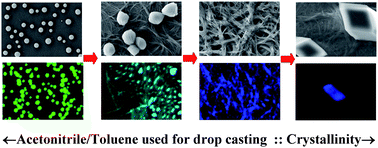Hierarchical assembly of a molecular material through the amorphous phase and the evolution of its fluorescence emission†
Abstract
Fabrication of an amorphous phase followed by a hierarchy of forms leading to the crystalline state offers a new dimension in the assembly of small molecule based materials. The morphology and extent of crystallinity of the


 Please wait while we load your content...
Please wait while we load your content...